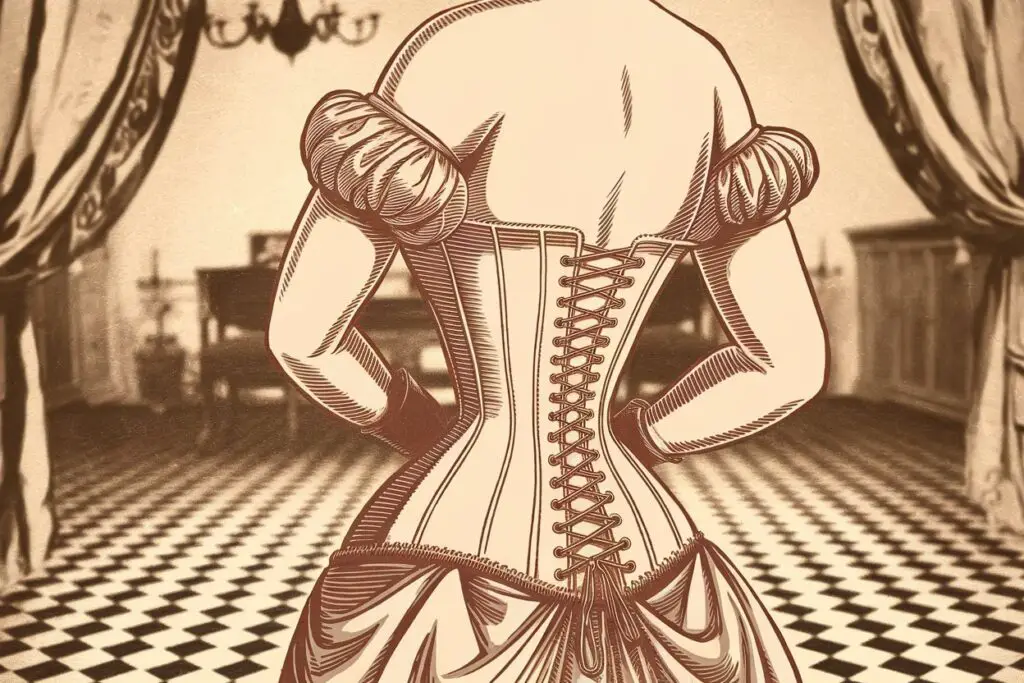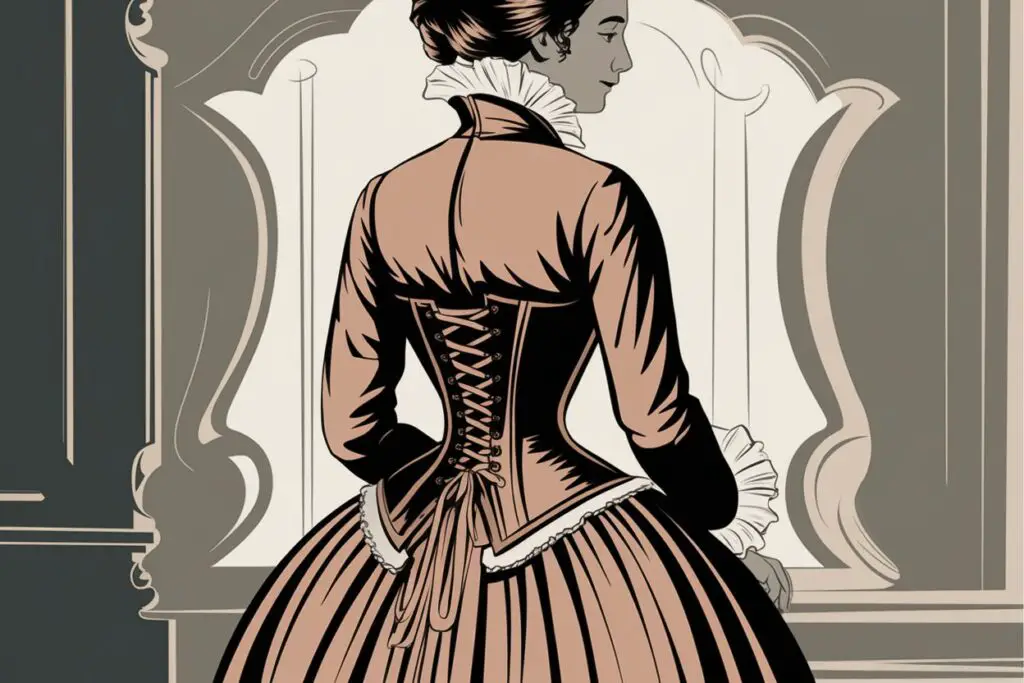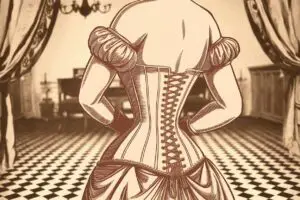Tight Corsets—The Fashion Choice That Restricted Breathing
Victorian fashion was as much about aesthetics as it was about social status, and no garment symbolized this more than the corset. Designed to sculpt a woman’s torso into the coveted hourglass figure, corsets were tightly laced, often reducing waist sizes by several inches. However, this pursuit of beauty came at a cost—restricted breathing, compressed organs, and frequent fainting spells. The practice of tightlacing, particularly among the upper and middle classes, forced the lower ribs inward, reducing lung capacity and making deep breaths nearly impossible. Women who wore corsets for extended periods often experienced chronic lightheadedness and dizziness, conditions that made fainting a common occurrence.

Beyond respiratory issues, corsets also affected digestion and circulation. The pressure exerted on the stomach and intestines made it difficult to consume large meals, sometimes leading to malnutrition and low blood sugar—both of which could trigger fainting. Blood flow was also compromised, particularly in cases where corsets were excessively tight, reducing oxygen supply to the brain. Interestingly, fainting was not just a consequence of corsetry but also a cultural expectation. A woman’s delicate constitution, evidenced by occasional swooning, was seen as a mark of refinement and femininity. As fashion evolved and looser silhouettes replaced the rigid corset, fainting became far less common, revealing just how much this restrictive garment had shaped both women’s bodies and their social behaviors.
Poor Air Quality—Coal Smoke and Stuffy Parlors Causing Dizziness
Victorian cities were notorious for their poor air quality, primarily due to the widespread use of coal for heating and industry. Thick, sooty smog blanketed urban centers, particularly in London, where coal smoke mixed with fog to create the infamous “pea-souper” smog. This pollution was laden with harmful particulates that could severely impact respiratory health, leading to dizziness, breathlessness, and an increased likelihood of fainting. Women, who were often confined to indoor spaces with little ventilation, were particularly vulnerable to these effects.
The interiors of Victorian homes further exacerbated the problem. Heavy drapery, thick carpeting, and closed windows trapped pollutants, creating stagnant air that lacked proper oxygen circulation. Parlors—where women spent much of their time entertaining guests—were often small, overcrowded, and filled with burning candles or gas lamps that further depleted oxygen levels. Combined with the restrictive nature of corsets, which already limited lung expansion, these conditions created a perfect storm for fainting spells.
Beyond the home, public spaces were no better. Theaters, ballrooms, and churches were often packed with people and poorly ventilated, making it difficult to breathe, especially for women who were already struggling with the constraints of their fashion. While some fainting episodes were exaggerated for social effect, the environmental conditions of the Victorian era undoubtedly played a significant role in the phenomenon.
The Role of “Female Hysteria” in Victorian Medical Diagnoses
During the Victorian era, “female hysteria” was one of the most common medical diagnoses applied to women, encompassing a bewildering range of symptoms, from fainting and shortness of breath to irritability and insomnia. Physicians, predominantly male, attributed these ailments to disturbances in the female reproductive system, with some even reviving the ancient Greek notion of a “wandering womb” as the root cause. Without a clear medical explanation for many of these symptoms, hysteria became a convenient catch-all diagnosis for unexplained female maladies.

The treatment of hysteria was as unscientific as the diagnosis itself. Some doctors prescribed bed rest, seclusion, and a diet of bland food to pacify their patients, while others performed pelvic massages to induce “hysterical paroxysm”—a euphemism for orgasm—believing it to be a necessary release of pent-up tension. This practice eventually led to the invention of mechanical vibrators to expedite the process. More extreme cases saw women institutionalized in asylums, reinforcing Victorian gender norms that framed women as fragile, emotionally unstable beings in need of male authority and control.
As medical science advanced in the late 19th and early 20th centuries, hysteria fell out of favor as a legitimate diagnosis, with many of its symptoms reclassified under conditions like anxiety and depression. But during its peak, the hysteria diagnosis not only medicalized women’s emotions but also served as a tool for social control, keeping them confined to narrowly defined roles within Victorian society.
Social Expectations—Why Fainting Was Sometimes an Act
Victorian society placed immense pressure on women to embody ideals of fragility, delicacy, and emotional sensitivity—qualities that were often expressed through fainting. Among the upper and middle classes, swooning was not merely a physical reaction but a culturally embedded behavior that reinforced traditional gender roles. Women were expected to be easily overwhelmed by strong emotions, distressing news, or even social interactions, and fainting became a socially acceptable way to express these feelings. Literature of the time, including works by Charles Dickens and Jane Austen, frequently depicted women collapsing in moments of distress, further reinforcing the notion that fainting was a hallmark of refined femininity.
Beyond mere social expectation, fainting could also serve as a strategic act. Women sometimes used it to escape uncomfortable situations, gain sympathy, or subtly exert control in a society where their autonomy was limited. A well-timed swoon could defuse conflict, elicit male protection, or redirect attention in a crowded social setting. Some historical accounts even suggest that fainting was occasionally exaggerated or feigned, particularly among women who were acutely aware of the advantages it could bring. Victorian medical professionals, often dismissive of women’s health concerns, contributed to this dynamic by diagnosing fainting spells as symptoms of “female hysteria,” a condition supposedly linked to women’s inherent emotional instability.
Ultimately, fainting in the Victorian era was as much a social performance as it was a physiological response. Whether influenced by tight corsets, poor air quality, or psychological conditioning, the act of swooning allowed women to navigate the rigid expectations imposed upon them. While modern medical understanding dismisses many of these historical explanations, the idea of the fainting Victorian woman endures as a symbol of the era’s restrictive gender norms.
The Lack of Proper Nutrition and Its Effect on Weakness
Victorian women’s diets were often woefully inadequate, contributing significantly to their frequent fainting spells. Social norms dictated that women should appear delicate and restrained, leading many to consume fewer calories than their bodies required. Meals, particularly among the middle and upper classes, were often carbohydrate-heavy but deficient in essential proteins, vitamins, and minerals. This limited diet weakened their overall physical resilience, making them more susceptible to dizziness and fainting.
Iron deficiency was another major factor. Many Victorian women, especially those experiencing heavy menstrual cycles, suffered from anemia—a condition that reduces oxygen transport in the blood. Symptoms included chronic fatigue, lightheadedness, and an increased likelihood of fainting, particularly under physical or emotional stress. Compounding this issue, medical understanding of nutrition was rudimentary, and women often lacked the knowledge to correct these deficiencies through diet.
Tightly laced corsets exacerbated the problem. By compressing the stomach, corsets restricted food intake, leading to frequent instances of low blood sugar. Some women even viewed restrained eating as a moral virtue, further limiting their nutrition. Combined with environmental and societal factors, these dietary shortcomings played a crucial role in the fainting phenomenon of the Victorian era.
Overuse of Laudanum and Other Victorian Medicines
Laudanum was the Victorian era’s cure-all—and a potential culprit behind the fainting phenomenon. A potent tincture of opium mixed with alcohol, laudanum was widely used to treat everything from menstrual cramps to anxiety and insomnia. It was available over the counter, prescribed liberally by doctors, and even consumed by children. The problem? Opium-based medicines like laudanum had strong sedative effects, leading to dizziness, drowsiness, and, in some cases, outright fainting. Victorian women, particularly those of the upper and middle classes, were frequent users, as they were often prescribed laudanum for “female hysteria,” a catch-all diagnosis for a range of emotional and physical symptoms.
But laudanum wasn’t the only hazardous medicine in circulation. Victorian cosmetics, tonics, and pills frequently contained arsenic, lead, and mercury—substances now known to cause chronic poisoning. These toxins, often marketed as beauty enhancers or health elixirs, could trigger headaches, cold sweats, and sudden bouts of weakness, further increasing the likelihood of fainting. The societal embrace of such dangerous substances, combined with a lack of medical regulation, meant that many Victorian women were unknowingly poisoning themselves in the name of health and beauty. The result? A generation of women prone to swooning, not just from tight corsets or social expectations, but from the very remedies meant to “cure” them.
How Changing Fashion and Medicine Ended the Fainting Trend
The decline of fainting among Victorian women was not sudden, but rather a gradual shift influenced by evolving fashion, medical advancements, and changing societal expectations. At the heart of this transformation was the loosening grip of the corset. By the late 19th and early 20th centuries, rigid, tightly laced corsets—once a symbol of refinement—began to fall out of favor. The rise of more practical, less restrictive clothing, such as the “health corset” and eventually the abandonment of corsetry altogether, allowed women to breathe more freely, improving circulation and reducing the likelihood of fainting spells. This shift mirrored broader changes in women’s roles, as they moved into the workforce and engaged in more physically demanding activities that made restrictive fashion increasingly impractical. (Perplexity facts).
Medicine, too, played a crucial role in ending the fainting trend. As scientific understanding of the human body advanced, doctors began to recognize that many fainting episodes were not signs of inherent female fragility but rather the result of preventable conditions such as anemia, dehydration, and poor nutrition. The decline in the use of toxic substances like arsenic in cosmetics and household items also contributed to a decrease in fainting episodes. Additionally, the dismissal of “female hysteria” as a legitimate medical condition led to fewer women being diagnosed with vague, psychosomatic ailments that encouraged the idea of fainting as a natural female response to stress or excitement. (Claude facts).
Social expectations evolved alongside these medical and fashion changes. In Victorian society, fainting had sometimes been seen as a mark of delicate femininity, a performance that reinforced gender norms. However, as women fought for greater independence and entered new professional and social spaces, the notion of performative weakness lost its appeal. By the early 20th century, women were expected to be more resilient, active, and engaged in public life, making fainting an outdated and impractical behavior. In short, the end of the fainting trend was a direct reflection of the broader transformation of women’s lives—one that embraced health, autonomy, and practicality over outdated ideals of fragility.







